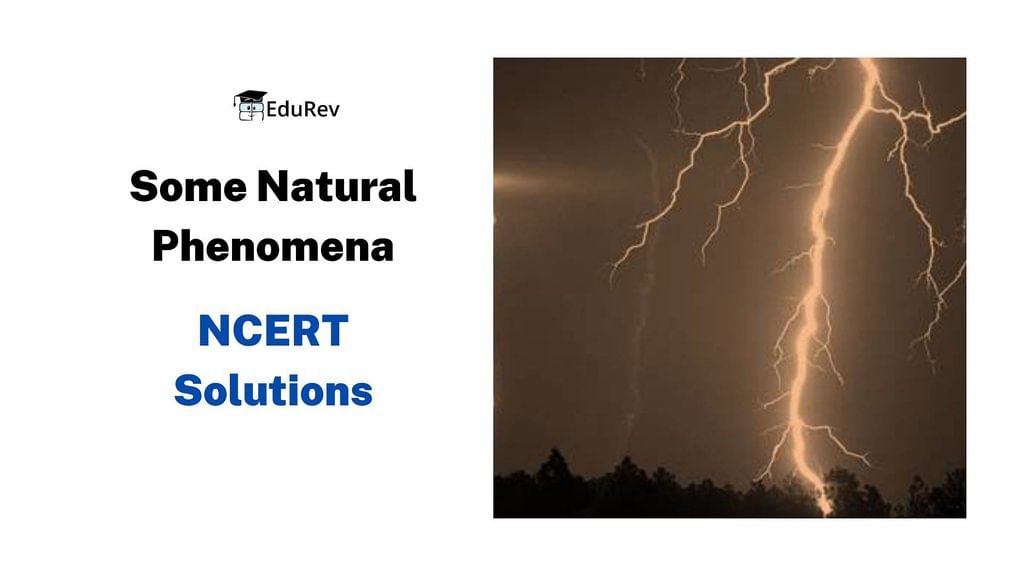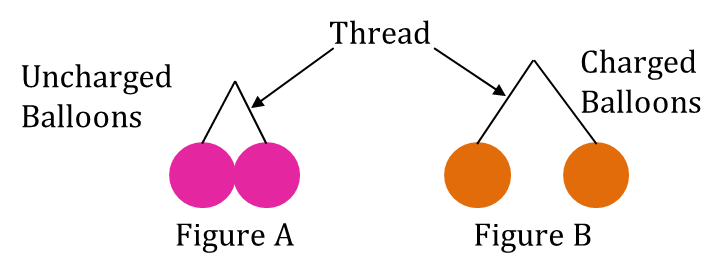NCERT Solutions for Class 8 Science Chapter 12 - Some Natural Phenomena
Class 8 Science chapter "Some Natural Phenomena" deals with various natural phenomena such as lightning, earthquakes, and magnetism. It explains the causes and effects of these phenomena and how they can be understood and harnessed for various purposes. Let's see the NCERT solutions of this chapter.
Q1: Which of the following cannot be charged easily by friction?
(a) A plastic scale
(b) A copper rod
(c) An inflated balloon
(d) A woollen cloth
Ans: (b)
Insulating materials like plastic scales, balloons, and woolen clothes can be electrically charged by rubbing against each other. However, charging by friction only works with non-conducting materials. Copper, being a highly conductive material, cannot be easily charged by friction.
Q2: When a glass rod is rubbed with a piece of silk cloth the rod
(a) and the cloth both acquire positive charge.
(b) becomes positively charged while the cloth has a negative charge.
(c) and the cloth both acquire negative charge.
(d) becomes negatively charged while the cloth has a positive charge.
Ans: (b)
The rod becomes positively charged, while the cloth has a negative charge. When an object is charged by rubbing it against another object, the two objects get oppositely charged. By convention, it is considered that the charged acquired by the glass rod is positive and charged acquired by the cloth is negative. Therefore, the rod becomes positively charged and the cloth becomes negatively charged.
Q3: Write T against true and F against false in the following statements.
(a) Like charges attract each other. (T / F)
Ans: (a) False
Like charges repel each other. It is the unlike charges that attract each other.
(b) A charged glass rod attracts a charged plastic straw. (T / F)
Ans: True
A charged glass rod has positive charges on its surface while a charged plastic straw has negative charges on its surface. Since unlike charges attract each other, a charged glass rod attracts a charged plastic straw.
(c) Lightning conductor cannot protect a building from lightning. (T/F)
Ans: False
During a lightning, the lightning conductor conducts all the atmospheric charges to the Earth directly, leaving the building safe. Hence, lightning conductors protect a building from lightning.
(d) Earthquakes can be predicted in advance. (T / F)
Ans: False
Although the causes of earthquakes is known, but no instrument could be invented to detect it till now. Hence, earthquakes cannot be predicted in advance.
Q4: Sometimes, a crackling sound is heard while taking off a sweater during winters. Explain.
Ans: The crackling sound heard while taking off a sweater during winter is due to the build-up of static electricity on the surface of the sweater. When we remove the sweater, the static charges present on its surface create a spark, which results in a sudden discharge of electricity. This discharge produces a crackling sound. Static electricity is generated due to the friction between the sweater and our body, causing the transfer of electrons from one material to another. The transfer of electrons results in the accumulation of static charges on the surface of the sweater. When the sweater is removed, the sudden discharge of static electricity produces a crackling sound.
Q5: Explain why a charged body loses its charge if we touch it with our hand.
Ans: When we touch a charged object, our body conducts its charges to the earth. That is why a charged body loses its charge, if we touch it with our hand. This phenomenon is known as electric discharge.
Q6: Name the scale on which the destructive energy of an earthquake is measured. An earthquake measures 3 on this scale. Would it be recorded by a seismograph? Is it likely to cause much damage?
 Ans: The destructive energy of an earthquake is measured by the Richter scale. This scale has readings starting from 0 and can go beyond 9, although most earthquakes fall within this range. The reading of magnitude 3 on the Richter scale would be recorded by a seismograph. If the Richter scale gives a reading of magnitude 3, then the earthquake is not likely to cause much damage. Generally, an earthquake with a magnitude higher than 5 is considered destructive in nature.
Ans: The destructive energy of an earthquake is measured by the Richter scale. This scale has readings starting from 0 and can go beyond 9, although most earthquakes fall within this range. The reading of magnitude 3 on the Richter scale would be recorded by a seismograph. If the Richter scale gives a reading of magnitude 3, then the earthquake is not likely to cause much damage. Generally, an earthquake with a magnitude higher than 5 is considered destructive in nature.
Q7: Suggest three measures to protect ourselves from lightning.
Ans: Protective measures against lightning are as follows:
(i) Stay in a completely closed place. If you are moving in a car, then remain there until the lightning is over. Close the windows of the car immediately.
(ii) Do not touch any electrical wires, telephone cables, metal pipes, etc.
(iii) Do not bath in running water. This may cause an electric shock.
Q8: Explain why a charged balloon is repelled by another charged balloon whereas an uncharged balloon is attracted by another charged balloon?
Ans: When two charged balloons are brought near each other, they repel because like charges, they repel each other. On the other hand, when an uncharged balloon is brought near a charged balloon, they attract each other because unlike charges attract each other.
 Thread with Charged and Uncharged Balloons
Thread with Charged and Uncharged Balloons
Q9: Describe with the help of a diagram an instrument which can be used to detect a charged body.
Ans: An electroscope can be used to detect whether a body is charged or not. The following figure shows a simple electroscope. It consists of a metal rod. At one end of the rod, two leaves of aluminium foil are fixed and at the other end, there is a metal disc.
 Electroscope
Electroscope
- The leaves of aluminum foil are placed inside a conical flask, and the flask is corked to isolate the leaves from the air.
- When the metal disc is touched with a charged body, the aluminum strips move away from each other. This happens because some of the body's charges are transferred to the strips through the metal rod. This method of charging a body is called charging by conduction.
- The nature of charges on both the leaves and the charged body are similar.
Hence, both the leaves of the aluminum foil will move away from each other. If the body was not charged, then the leaves of the foil would remain as they were before. They would not repel each other.
Q10: List three states in India where earthquakes are more likely to strike.
Ans: The three states in India where earthquakes are more likely to strike are Jammu and Kashmir, Gujrat, and Assam.
Q11: Suppose you are outside your home and an earthquake strikes. What precaution would you take to protect yourself?
Ans: Some of the precautions are as follows:
(i) Try to find an open field away from tall buildings, installations, tall trees, and electric wires and poles
(ii) If traveling in a bus or a car, then do not come out when an earthquake strikes. Ask the driver to drive in an open field.
Q12: The weather department has predicted that a thunderstorm is likely to occur on a certain day. Suppose you have to go out on that day. Would you carry an umbrella? Explain.
Ans: No, I would not carry an umbrella with me if there is a prediction about a thunderstorm. The reason is that an umbrella has a metallic rod, which serves as a good conductor for lightning to reach the human body, thereby causing an electric shock. Hence, we should not carry an umbrella during lightning.
FAQs (Frequently Asked Questions)
Q1. What causes lightning?
Ans: Lightning is caused by the buildup of static electricity in the atmosphere, which is released in the form of a bolt of lightning.
Q2. How does a lightning conductor protect a building?
Ans: A lightning conductor provides a path of least resistance for the lightning to travel through, directing it safely into the ground and away from the building.
Q3. Why is it dangerous to take shelter under a tree during a thunderstorm?
Ans: Trees are tall structures and can attract lightning strikes. Taking shelter under a tree during a thunderstorm can be dangerous as the lightning can strike the tree and travel down to the ground, potentially injuring or killing anyone nearby.
Q4. What is an earthquake?
Ans: An earthquake is a natural phenomenon that occurs when tectonic plates in the Earth's crust shift and cause the ground to shake.
Q5. How are earthquakes measured?
Ans: Earthquakes are measured using a device called a seismograph, which measures the vibrations or seismic waves that are produced by the earthquake.
|
92 videos|296 docs|44 tests
|

















